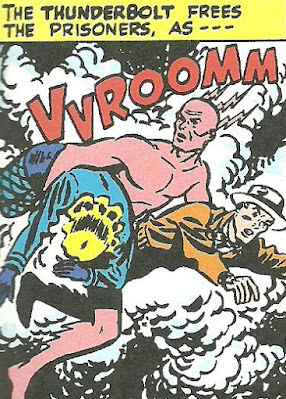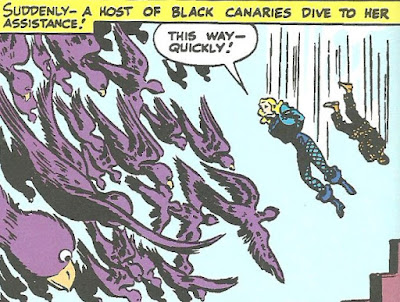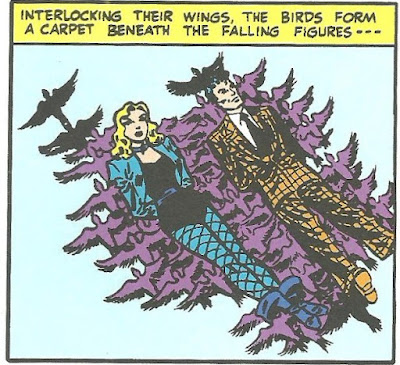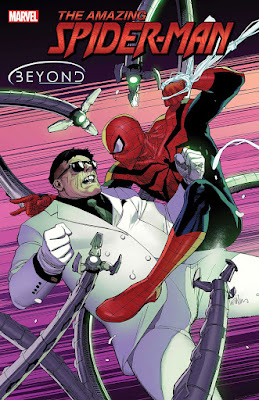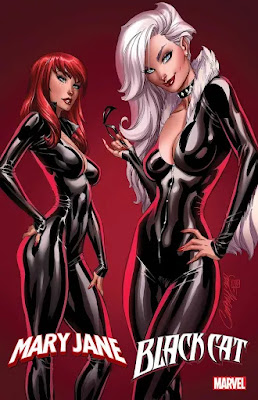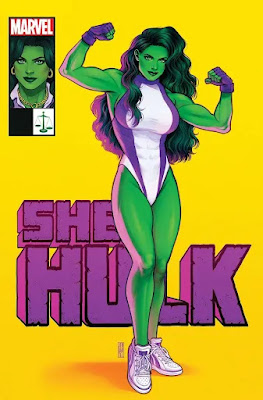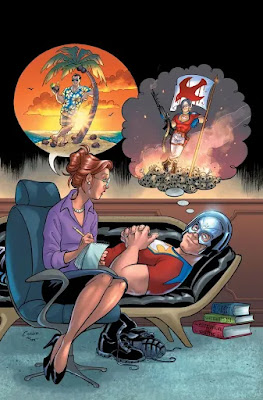Extreme Justice #0-4 (1995) "It's not really that bad if you can look past the art" is a heck of a thing to say about a comic book, given the visual nature of the medium and the fact that the art is supposed to be doing the bulk of the storytelling, but it's perhaps more true of the early issues of Extreme Justice than any other comics I can recall reading at the moment.
The title seems born of the tensions at the publisher to just keep on doing what they've been doing and a need to try to appeal to the readers of Marvel's various X-books and the blockbuster (but generally terrible) comics that upstart Image Comics produced in its earliest years.
And so the team line-up includes several stalwarts from the late 1980s/early 1990s Giffen/DeMatteis Justice League comics (Blue Beetle, Booster Gold, Captain Atom) paired with newcomers Maxima (from Dan Jurgens' run on Justice League America, rather recently repackaged and republished in trade as Superman and Justice League America) and Amazing-Man, a new legacy version of All-Star Squadron character introduced in 1983.
It spins pretty directly out of the pages of the "Judgement Day" crossover (collected in Wonder Woman and Justice League America), with the Justice League splintered into three different teams, each appearing in a different title (Wonder Woman's team would occupy Justice League America, Martian Manhunter's Justice League Task Force and Captain Atom's the poorly-named Extreme Justice).
And yet there was that silly title, one that didn't really reflect the raison d'etre of the superhero team that writer Dan Vado had Captain Atom articulating; rather than being an in-your-face, proactive super-team as is so often attempted by the super-comics publishers, Atom wanted to return to the days of the pre-Satellite Era Justice League, when the team didn't require so much bureaucracy (although even the original Justice League and their precursors the JSA were never short of meetings and organization). It's perhaps worth noting that the name "Extreme Justice" never appears anywhere in the first five issues of the title, other than on the covers; if the heroes ever refer to their team, they use the name "Justice League."
And there's the artwork of pencil artist Marc Campos and inker Ken Branch, in which a reader can find any of the stereotypical sins attributed to 1990s super-comics artwork, from there only being two body types ("superhero" and "superheroine"); questionable anatomy; questionable point-of-view; backgrounds consisting of either empty space, rubble or explosions; screaming mouths filled with saliva; and, every once in a while, a panel like this, where even the questionable anatomy seems to have completely broken down in such a way it seems peculiar that DC Comics would have even published the image.
I mean, for as much as they might have been striving to imitate the work of a Rob Liefeld at Image Comics, they were still DC Comics and not Image, you know?
As much temptation as there is to make fun of Campos' art, and as much as it might seem to deserve it, I have to keep reminding myself that DC was very clearly asking for this sort of style with the book, so if anyone deserves the blame for the way the book looks, it's as mucyeditors Brian Augustyn and Ruben Diaz, who were "proudly present"-ing it, and it was Campos for drawing it.
Anyway, as bad as the book looks, Dan Vado's script isn't actually that bad. I've definitely read worse Justice League stories with less excuses for being as bad as they were.
The series, which launches in a zero issue because of course it does, has Captain Atom leading his mini-League against a rogue U.S. general who wants to start World War III by preemptively attacking the Soviet Union...or was it Russia at the time...? I wasn't very up-to-speed with geopolitics that years, as I was only 17.
Deciding they need a new base to hang out in, the time-lost Captain Atom suggests they squat in Mount Thunder, a giant underground base built for parts of the U.S. military to ride out a nuclear war in the '60s but then abandoned. Unfortunately, someone else is already squatting there, another rogue U.S. general, one who leads up a conspiracy called "Freedom Rings" that wants to destroy what he feels is another, more sinister conspiracy within the U.S. government, one apparently involving "President French Fry" (Clinton, I guess, if it's 1995).
Rather than, like, vacating when the armed forces come to kick them out, or telling anyone else that there's a team of killer cyborgs living in the secret base, Captain Atom and the gang remain there until they've blown up all the cyborgs and the bad guy kills himself in an explosion. I guess then they get to live there...? I don't know how U.S. military bases work, I guess.
Meanwhile, the superpower-less Ron Raymond has developed leukemia and has a pretty dire diagnosis. Skeets and Oberon find him at what used to be the Justice League base in New York City and follow him back to Pittsburgh, where his powers suddenly return and he loses control of them. That's the cliffhanger ending of the fourth issue, in which Professor Stein telepathically tells Ronnie he's going to return to Earth, as he's out in space being a fire elemental or whatever he was doing at that point, exactly.
The fourth issue has fill-in art by pencil artist Mozart Cuoto, and it's much better looking than Campos'. The book is infinitely more readable this issue.
All in all, it's a pretty odd book. I like the Amazing-Man character quite a bit though, and found myself eager to see how he would develop in the book's remaining 15 or so issues (Amazing-Man II Will Everett would be on my theoretical Justice League line-up, if I were the boss of who should be on the Justice League, by the way). And I've built up an affection for Booster Gold and Blue Beetle over the years, even if neither of them is particularly well-written or given any real characterization in these pages (Blue Beetle doesn't want to be relegated to the tech guy, and Booster is worried that Captain Atom will kick him off the team if he realizes how weak his heart is and....that's about it for these guys in these issues).
So yeah, it feels weird and wrong to say, but it's honestly not really that bad if you can look past the art.
Now I've gotta find somewhere to buy the rest of the series, as this was all the shop I got these from had...
Showcase '95 #1 (1995) This is the first issue of DC's mid-nineties resurrection of their old Showcase series to star a Superman supporting character in the lead slot. For the first two years,
Showcase '93 and
Showcase '94, Batman supporting characters anchored the series; for the last two years,
Showcase '95 and
Showcase '96, Superman characters would.
The reason I picked this up now—in addition to being mildly curious about the entire series, which I just read extremely sporadically back when it was being released, of course—was that this particular issue featured an Alan Scott back-up, and one of some significance. While Alan had previously been de-aged and given a new costume, and he had previously given up his ring and Green Lantern name, this story features the return of his powers and the first time he decided on his new superhero name: Sentinel.
In a theoretical Green Lantern: Sentinel trade collection that doesn't exist but I kinda wish did, this would appear somewhere between the Green Lantern Corps stories and 1998's Green Lantern/Sentinel: Heart of Darkness.
The story, written by R.A. Jones and drawn by Gene Gonzales and Wade Von Grawbadger, finds Alan, in full costume, and his wife Molly at a cemetery, presumably lingering long after the funeral for some of the original Justice Society members killed during Zero Hour: Dr. Mid-Nite, Hourman and The Atom. Alan tells Molly he's going to stay behind to brood a while longer, and once she leaves the dead heroes come to life and attempt to kill Alan, punishing him for being a coward and giving up superhero-ing while they went down fighting.
His power returns, he reburies them and questions whether it was a combination of his power and his own feelings of guilt that resurrected them, and then declares, "I'm starting a new life--reborn by the fires of The Starheart-- --and I will become its-- SENTINEL!", and that last word is all big and green and on fire, like a logo.
It ends with a three-panel sequence in which a sorcerer apparently named Torquemada talks to himself about how he conjured the JSA zombies and how he will need Alan's help against the evil one, and instead of "The End" it ends with "So it begins!"
I...have no idea where. Next issue doesn't feature an Alan Scott story, nor do I think he returns the rest of the year. If you know where it picks up, if it ever does, do be sure to let me know.
The lead Supergirl story is perhaps most notable for its artwork, by one Stuart Immonen, inked by Wade Von Grawbadger. Written by Charles Moore, it features a fairly generic sentient robot alien conqueror type coming to earth to get some rare minerals and stumbling upon Supergirl, whose body he would like to take over as his own. That is because this is one of the confusing Supergirls, the post-Byrne one who is like actually made of protoplasm and has a variety of powers that differ from Superman's (another confusing Supergirl, which is actually maybe the same one with some extra layers of confusing continuity added, appears in Superman 80-Page Giant #2, below).
Rounding out the issue is a short story starring Argus, one of the "New Bloods" heroes introduced during 1993' Bloodlines event (and created by Mark Waid and pencil artist Phil Hester). Here he is written by Mark Wheatley and Allan Gross, penciled by Hester and inked by Wayne Faucher.
It's an odd little story in which the hero encounters a boy who has a ray gun that dissolves clothing; he attacked a charity fashion show in order to see the models naked and, when Argus intervenes, he evaporates his costume, leaving the hero running away naked on the TV news. From there, he needs to find a new costume, which proves difficult to heroes who aren't secretly billionaires with costume-designing butlers, I guess.
I'm not really familiar with Argus, having never read the Flash Annual that introduced him—but I'd like to! I'd like to read al the Bloodlines annuals! Collect 'em for me, DC!—but I thoroughly enjoyed seeing Hester's art work here, a much earlier point than I had seen it for the first time previously (his run on Green Arrow). I'm a fan.
Steel Annual #1 (1994) The first of the two
Steel annuals was released during the year in which the theme was simply "Elseworlds", so each of the year's 23 annuals featured and alternate reality tale featuring the comic's regular star or stars (I've read hardly any of these, I think just the
Detective Comics annual, which introduced "Captain Leatherwing," the pirate Batman, and
Shadow of The Bat; if DC wants to go ahead and collect all of these into a couple of trades, I'd happily buy them. Much easier than finding them one at a time in back-issue bins).
Co-written by Steel co-creator Jon Bogdanove and a Judith Kurzer Bogdanove, who I am assuming is his wife, and entitled "Crucible of Freedom," the premise is a perhaps interesting but awfully tricky one to tackle: What if John Henry Irons became steel not in modern day Metropolis, but in the American South in the 1860s? What if he was born a slave on cotton plantation?
It certainly makes for a satisfyingly melodramatic arc, as we see the protagonist and generations of his family subjected to the most terrible evil for pages and pages before Irons eventually dons his armor and liberates the plantation through force, now protected not only from whips but even bullets and cannon balls.
But it also makes for a rather rough read. This is certainly the first time—and perhaps the only time?—I've seen the N-word appear in a DC Comic. And then, of course, there's an awful lot of beatings, whippings and talk of the same, although in comics form they aren't quite as tough to watch as they might be in, say, a film, where you can hear the snap of a whip over and over.
Some of the harshest elements occur off-panel and in the reader's imagination—the villain blinds a black man with a sword for daring to meet his eyes, the evil overseer is murdered with a pitchfork, a wagon full of infants is drowned in a sudden downpour—but it's still awfully rough-going for a mainstream comic book.
In the Bogdanoves' story, John Henry is nursed alongside Arthur Forrest, the scion of the plantation. The two grow up playing as best friends, with Arthur sneaking books to John Henry and teaching him to read, but, as they grow older, they grow apart. Eventually Arthur blames John Henry for his being sent away to a school, and vows revenge; being spurned by a lady who then goes on to have sex with a slave doesn't help dispel his race hatred in the least.
Meanwhile, John Henry grows up to be not only smart, but huge and noble, willing to take the beatings meant for other, weaker slaves regularly. He's also the plantation's blacksmith, and, when the Civil War breaks out, Arthur, who has a life-long interest in tales of medieval chivalry, demands John Henry build him a suit of armor with which he can do battle.
John Henry reluctantly sets to work, coming up with a 19th century version of the familiar Steel armor, complete with a wrist-mounted Gatling gun, but it's sized to fit him, not Arthur. When the slaves rise up, he dons the armor, picks up his hammer and helps fend off the Confederate troops training on the plantation and ultimately confronts Arthur who, in true melodramatic villain fashion, ultimately kills himself while trying to destroy the hero who, of course, is too noble to take his life.
It's all rather compelling, although I was somewhat surprised to see the pencil artist who was given the assignment: Humberto Ramos, a manga-influenced artist who would soon become best-known for his work on Impulse. While the art, inked by seven different artists, is highly readable and flows perfectly fine, Ramos doesn't really imbue it with the gritty, realistic feel the story seems to call for, and his style is often at odds with the subject matter.
The climax, however, the part where the comic becomes a superhero comic again, is handled quite well.
In a neat bit of symmetry, the Bogdanoves link this version of John Henry Irons to the folk hero who inspired the "real" version of the character's name. The story ends with a splash page full of prose text, which includes the lines, "Still others believe...that it was he who, at the age of 65, challenged and beat the infamous 'inky-doo' spike-driving machine that threatened to replace human labor with machinery...striking a fabled last blow for human rights before he died!"
It is one of several possible futures that the text lays out, and, indeed, several of them are interesting enough to at least be suggestive of sequels that never came; would Steel join the forces of the Union in his remarkable armor, or supply them with weapons, and help topple the Confederacy?
I'm personally not crazy about the design of his armor, which, for some reason seems to be more golden than iron or steel. Perhaps it's meant to be made of copper, but the subtlety of metal variations was apparently too much for the coloring of 1994, and thus it looks yellow, which translates too easily to gold in a reader's mind. On the other hand, I suppose the color does contrast sharply with the armor of the normal, non-Elseworlds version of Steel's armor, making it immediately apparent with a glance at the cover that this is meant to be a different version of Steel.
Superman 80-Page Giant #2 (1999) The second of the late 1990s
Superman 80-Page Giants came in the wake of the "Superman: King of the World" storyline. While it's not terribly important to have read or to remember that story arc from the Superman books of the time in order to follow the stories in this anthology—I only read a few key parts of it and some crossovers—it entailed Superman gradually becoming more and more zealous in his protection of the world, to the point that he begins taking it over with an army of his robot duplicates. The Superman bent on making himself king of the world ends up not being Superman at all, but villain Dominus disguised as Superman. So each of the seven short stories here has Superman meeting with or interacting with one supporting character or another, generally apologizing or trying to get them to forgive and trust him again.
The best story of them all may actually be the first one, starring Superman himself, by Mike Friedman and Peter Doherty. In it, Superman swoops in and rescues a man who was trying to commit suicide, and then decides to have a cup of coffee with him and talk things over. Emergencies keep arising though, and since Superman can't leave the man alone, he takes him with him, the man ultimately helping to deliver a baby while Superman deals with another emergency.
It's a pretty great, evergreen Superman story, and while it's prompted by the "King of the World" story, in which it shows how the "real" Superman deals with the fear of things spiraling out of his control, it also shows how he accepts it (that is, without actually having to control the entire world and having a Superman robot on every corner).
The other half-dozen stories star Steel, Wonder Woman, Jimmy Olsen, Supergirl (here in her angel phase), Lex Luthor and Lois Lane. My favorite of these were probably the Steel and Wonder Woman stories, by Chuck Dixon, Scott Beatty, Eric Canete and Shawn Martinbrough and Eric Luke, Brian Denham and Andy Lanning, respectively, because they're both fairly strong just-two-heroes-hanging-out stories. The Steel one is set during the time when both heroes were on the Justice League, and Martian Manhunter makes a brief cameo (along with his cookies); the Wonder Woman one reads a little weirdly today, if only because it involves her feelings for Superman and the fact that she's sort of bummed that they're just friends and that he's in love with his wife.
Among the perhaps unexpected creators involved are Mike Oeming (no Avon, just Oeming) and Mark Millar.
Oeming draws the Jimmy Olsen story, in which Superman's pal must endure his friends' ribbing and his own distrust of Superman, while he's ultimately involved in a rather Jimmy Oslen-ish sceneario (this one's written by Joe Casey).
Millar writes—well, overwrites, really—the Lois Lane story, in which she talks about how and why she loves him, and while he might not care how others think of him, she does. This ones drawn by Sean Phillips, and, I don't know, it's downright weird encountering pre-Authority Mark Millar these days. I don't know if it was the tight leash of corporate super-comics editors or what, but the early Millar seemed like a much stronger, sharper, more incisive writer than the later, high-concepts for media adaptation Millar.
It's far from Millar's best Superman writing—that actually would be his issues of Superman Adventures—but it's head and shoulders above much of his post-Big Two superhero writing.














